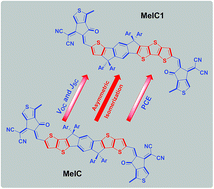Designing an asymmetrical isomer to promote the LUMO energy level and molecular packing of a non-fullerene acceptor for polymer solar cells with 12.6% efficiency†
Abstract
Isomers with small structural changes usually exhibit different properties. Rationally designing isomers of some high-performance SMAs can further enhance their function. In this work, an asymmetrical small molecule acceptor (SMA) MeIC1 isomerized from MeIC is reported. Compared with the symmetrical MeIC, the asymmetrical isomer showed almost the same absorption range but an elevated LUMO energy level and simultaneously enhanced π–π stacking and electron mobility by replacing the thieno[3,2-b]thiophene unit with a larger sized dithieno[3,2-b:2′,3′-d]thiophene unit in the ladder-type core of MeIC. As a result, the MeIC1-based PSCs achieved a higher PCE up to 12.58% with a promoted Voc and Jsc and an unchanged FF compared with those of MeIC-based PSCs when blended with PBDB-T. This work reveals that asymmetrical isomerization is effective for PCE promotion.



 Please wait while we load your content...
Please wait while we load your content...